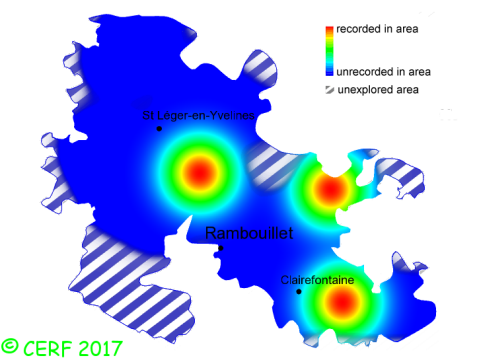|
Lactarius obscuratus (Lasch:Fr.) Fr.
|
common name(s) : Alder Milkcap
New classification: Basidiomycota/Agaricomycotina/Agaricomycetes/Incertae sedis/Russulales/Russulaceae
Former classification: Basidiomycota/Homobasidiomycetes/Agaricomycetideae/Russulales/Russulaceae
synonyms: Lactarius obnubilus, Lactarius obscuratus-radiatus, Lactarius clethrophilus
(unconfirmed synonyms: Lactarius obnubilis)
edibility : inedible
|
|
|
The cap is orange-brown, with a darker olive green centre, hygrophanous, drying to whitish buff, convex to flattened, then depressed, with a darker central umbo, more or less pointed; its margin is striate, due to the gills showing through.
The cap surface is smooth, slightly greasy.
The stem is hollow, cylindrical or slightly swollen at the base, smooth, pale ochre to reddish-ochre, more so towards the base, without ring.
The flesh is cream to brown, more or less pinkish, unchanging; its taste is mild to slightly astringent; the odour is faint, fruity;
its texture is grainy (breaking like a chalk stick), exuding when cut a white or transparent milk, unchanging or turning slightly yellow on a cloth after one minute.
The gills are pinkish cream then orange-red, adnate to slightly decurrent, thin and rather crowded .
The spore print is white (A). This species is mycorrhizal.
It grows on the ground, in damp woods, swamps or bugs, on a rather humid, rich with nutrients soil, only with alder.
The fruiting period takes place from June to December.
| Dimensions: | width of cap approximately 2 cm (between 0.6 and 3.5 cm) |
| | height of stem approximately 2.5 cm (between 1 and 3.5 cm) |
| | thickness of stem (at largest section) approximately 4 mm (between 2 and 7 mm) |
Distinctive features : orange-brown cap with olive shades, and a central and darker pointed umbo; small size; white to transparent milk, unchanging, with mild taste; in damp places, exclusively with alder
Lactarius obscuratus is quite rare and localised in the forest of Rambouillet, and is infrequent, more generally speaking
.
|  | | Above : distribution map of Lactarius obscuratus in the forest of Rambouillet |
|
page updated on 14/01/18